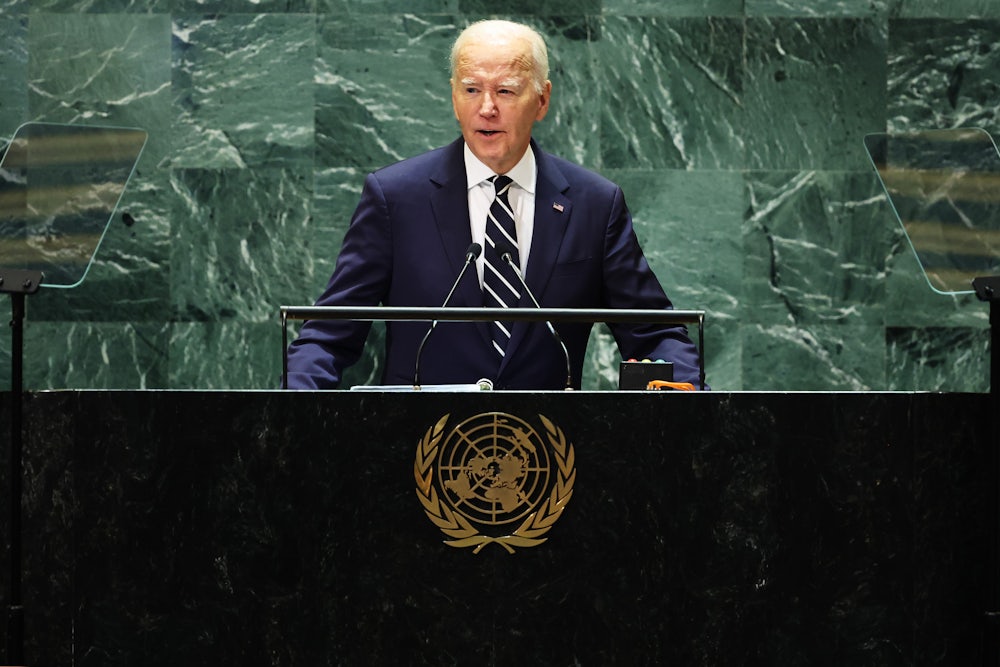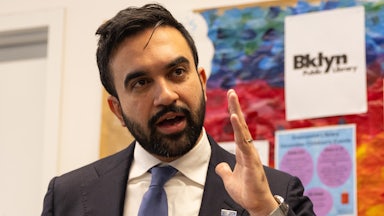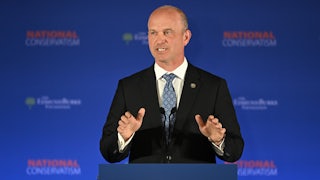In his final speech to the U.N. General Assembly this morning, President Biden promoted his administration’s foreign policy achievements. And he made a specific claim about America’s recent progress in fighting climate change. “Today, my country is finally on track to cut emissions in half by 2030,” he said. Unfortunately, that’s not true.
Biden was referring to the U.S. commitment under the Paris climate agreement, wherein all signatory countries pledge a certain level of emissions reduction toward that pact’s overall goal of limiting global temperature rise to “well below” two degrees Celsius (3.6 degrees Fahrenheit). The U.S. has pledged to reduce emissions by between 50 and 52 percent below 2005 levels by the end of this decade. In July, the Rhodium Group—a nonpartisan energy consultancy whose modeling the White House has leaned on heavily—directly contradicted Biden’s claim to have put that goal within reach. Rhodium projected that U.S. greenhouse gas emissions are currently on track to fall just 32 to 43 percent below that threshold by 2030.
That’s not to say there hasn’t been progress. But while the country is on track to reduce emissions faster than it was before the passage of the Inflation Reduction Act, those projected reductions are still “not enough for the US to achieve its 2030 climate commitment under the Paris Agreement of a 50-52% reduction by 2030, or deep decarbonization by mid-century,” Rhodium notes.
That goal may well be impossible now, Rhodium finds. Getting close would entail considerably more ambitious action than is currently being taken. The report discusses several possibilities, or “pathways.” Under the low-emissions pathway—where emissions fall 43 percent below 2005 levels by 2030, and by 56 percent in 2035—zero-carbon energy sources would be dramatically cheaper and more efficient, with “no exogenously imposed limit on wind and solar deployment” like backlogged interconnection queues and supply chain delays. Oil and gas prices would also be relatively high.
The low-emissions pathway, that is, would require far more aggressive policy than has been implemented thus far, and depends on several other items currently up in the air breaking the right way: Recent estimates, for example, suggest that electricity demand from energy-intensive data centers could increase 160 percent by 2030. In Rhodium’s low-emissions scenario, it grows by just 85 percent.
Biden throughout his speech on Tuesday also boasted about having overseen the “largest investment in climate and clean energy anywhere in history,” i.e., the Inflation Reduction Act. He and other White House officials will spend much of this week spreading this message at events organized as part of Climate Week NYC, an annual confab timed to coincide with the U.N. General Assembly. It’ll be up to Biden’s successor, though—ideally Kamala Harris, given Trump’s all-out hostility to climate policy—to make good on whatever best-case scenario remains for the U.S. to meet its climate goals as the time until 2030 runs out.
Meeting our Paris Agreement pledge would mean not just building on the modest progress made so far to invest in zero-carbon energy but adopting an altogether more confrontational approach overall. There’s no way to limit electricity demand from data centers—fueled by Silicon’s Valley rush into A.I. and cryptocurrency—without placing constraints on their appetite for unchecked, unnecessary expansion. Harris pledged nearly the opposite this week on the campaign trail, vowing to help boost investment in A.I. and crypto if elected. Like Biden, she’s also made keeping gasoline prices low central to her energy agenda, and boasted about its efforts to expand oil and gas production as an unalloyed good.
The shortcomings of the Biden-Harris administration’s approach to climate politics have been accompanied by policy failures elsewhere too—which were also on display on Tuesday. Opening up the U.N. General Assembly General Debate where Biden and other leaders give their speeches, U.N. Secretary General António Guterres warned about an “age of impunity,” chiding governments that “turn a blind eye to international human rights conventions or the decisions of international courts” and “thumb their nose at international humanitarian law” without consequence. The U.S. has done nothing to hold Israel even remotely accountable for slaughtering Gazans in schools, hospitals and refugee camps; raping prisoners; blocking humanitarian aid; killing U.S. citizens; and stoking a disastrous, arguably illegal regional war. Biden reaffirmed his administration’s enthusiastic support for the Israeli government this morning; the White House has shown no signs of slowing its billions of dollars in (also illegal) arms shipments now aiding its war effort. Harris refused even to meet with the Uncommitted activists demanding a cease-fire and arms embargo.
The “suffering in Gaza” Biden referenced in his U.N. General Assembly speech won’t end unless the U.S. is willing to challenge the government that’s causing it, and stop Israel sending weapons. Neither will the U.S. reduce emissions at the dramatic pace Biden and Harris have promised without being willing to challenge the corporate polluters that are driving them.








